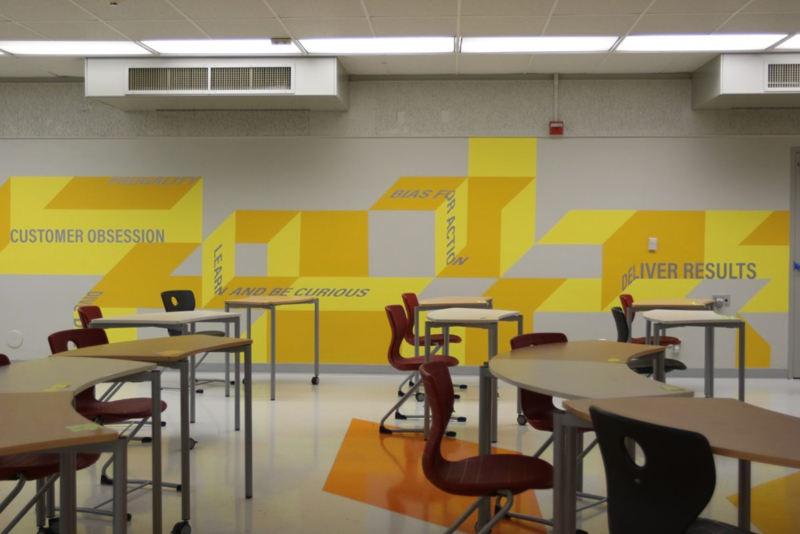Amazon is funding classes that teach high school students how to work at Amazon
Amazon is no stranger to making headlines for a sneaky business dealing or two, or five… However, the Big Five technology company, e-commerce giant, one-stop-shop grocery store and now, most recently, fashion retail store owner, has been revealed to have another card up its white-collar sleeve. It’s been uncovered that the company has been quietly paying for US high schools to teach a class on how to work at Amazon. Interestingly, the classes take place in California, where Amazon is currently the largest employer.
We’ve seen in the past how Amazon has caused widespread destruction for many people in its ever-growing and endless pursuit of profit. From accusations that the company lied to Congress in late 2021 to rigging its own search results and copying other sellers’ products in order to rack up sales, Amazon is no stranger to playing dirty. Even then, funding its own child-to-employee pipeline seems to be a new low.
While becoming an Amazon grunt may not be at the top of anyone’s aspirations list, what with the corporation’s many dealings with mistreatment of workers, it didn’t seem to stop Cajon High School in San Bernardino, California from making a deal with it in 2019. Back then, the school introduced the ‘Amazon Logistics and Business Management Pathway’ to its students, a “first-of-its-kind” class made up of a series of courses with the goal of getting youth interested in logistics. More than interested in influencing the next generation of workers, Amazon donated a cheeky sum of $50,000 (£37,075) to the high school in order to provide the necessary resources for the programme’s start.
Such courses have been offered by the company to teach students, among other things, how to motivate employees without having to mention common incentives like raises or increasing worker efficiency. The alarm bells are ringing pretty loud, I think.
Delving further into the somewhat dystopian concept, Futurism reported that students taking the classes are also required to participate in “work-based” internships at Amazon or a different logistics company. It’s already bad enough that the company is bringing in minors for their employee training programmes and squeezing out some labour from them in the process, but the choice of location for all of this really takes the cake.
The public high school is located only a stone’s throw away from neighbouring Riverside County, home to over 40,000 Amazon employees, which has doubled in the past four years alone, according to a Motherboard investigation.
This fact becomes even more troubling when considering the fact that Amazon proudly offers grants to the kids living in this region with high-living costs while it leaves a large number of Amazon employees seeking financial assistance high and dry. Futurism even goes a step further, noting that the set-up of these internships is similar to the tactic military recruiters use when targeting underprivileged students.
According to the San Bernardino City Unified School District Facilities Planning and Development website, the project—which currently has 96 enrolled students (64 of them in the 10th grade)—aims to teach students “information and decision technology, management systems, and business leadership.”
Furthermore, “The program enables students to practice innovative and critical thinking skills as they develop solutions to authentic logistics problems experienced by Amazon.” Partnered with Cal State University and Chaffey Community College, the pipeline extends into further education. Listed under the benefits section, the post-secondary element includes “post-diploma, certifications, and workforce internships” for students.

Now, here’s where innocent intentions clearly start to fade and suspicion starts creeping in. One of Amazon’s “necessary resources” includes branding the high school’s classrooms designated for such courses (dubbed the Logistics Lab) with Amazon-associated colours. Oh yes, that signature yellow that is splashed across the room pictured above. The redecoration doesn’t stop there, in a 1984-esque dystopian dream, the company’s values—also known as its ‘Leadership Principles’ which include: “CUSTOMER OBSESSION”, “BIAS FOR ACTION,” and “DELIVER RESULTS” are scrawled all over the rooms’ walls. Not quite as harrowing as “FREEDOM IS SLAVERY” but definitely more than a little nudge to become an Amazon worker.
I wrote about Amazon’s labor awakening for the "future of work" issue of this week's @NYTMag. The story covers two years in California’s Inland Empire, home to 14 Amazon facilities and over 40,000 of the company's employees. https://t.co/zSw0U5XU2U
— Erika Hayasaki (@ErikaHayasaki) February 18, 2021
On a class wall, Amazon’s giant logo grinned across a yellow and green banner. The words “CUSTOMER OBSESSION” and “DELIVER RESULTS” were painted against a corporate-style yellow backdrop. Each teenager wore a company golf shirt emblazoned with the Amazon logo.
— Erika Hayasaki (@ErikaHayasaki) February 18, 2021
So, what exactly does the class teach? Well, the curriculum covers a number of things. According to Motherboard, documents obtained via a public record request detail that the course consists of “lesson plans on managing labor unions,” “making ethical decisions,” and “motivating employees”.
So we’re just leaving out the part where there are lessons for managing unions in the course’s ‘Managing Human Resources and Labor Relations’ part when it’s widely known that Amazon has historically had a staunchly anti-stance on such matters? Students also get a rundown history lesson on the company in the ‘Global Logistics and Concepts’ unit, with Motherboard’s copy of the lesson’s description entailing: “Students will analyze and comprehend the footprint that Amazon has caused, and be motivated to participate in this exciting and growing field of e-commerce and logistics.” Not worrying at all.
High school preparation courses where students learn skills for future career paths with industry experts are not uncommon and actually have a multitude of benefits. Programmes within schools are often sponsored by or connected to companies with internships aligned, however, that doesn’t mean they are unbiased or that Amazon doesn’t influence anything that has to do with the scheme.
Documents obtained by Motherboard clearly confirmed the e-commerce giant’s interests in such courses, to “ignite student interest, create an intentional student, and provide an in-depth understanding and appreciation of the logistics community.” The documents outlined another intention of coaching teachers “how to establish and develop an effective industry partnership with Amazon.”
Unsurprisingly, not everyone is on board with this ongoing project to create mini Amazon employees. Eric Nilsson, an Economics professor at California State University (CSU) shared with Motherboard that it’s “concerning” that students are essentially signing up to a propaganda course housed inside “a shrine to Amazon.”
Though this is certainly not the first troubling tango Amazon has had with the education system—it’s only the latest one since the company’s foray into STEM-boosting programmes for middle and high school students—the issue here is that impressionable students are being specifically taught how to function as Amazon employees in an environment that is already dedicated to the company and with the prize of internships and job security dangling in their faces.
Speak about freedom of choice, huh?





